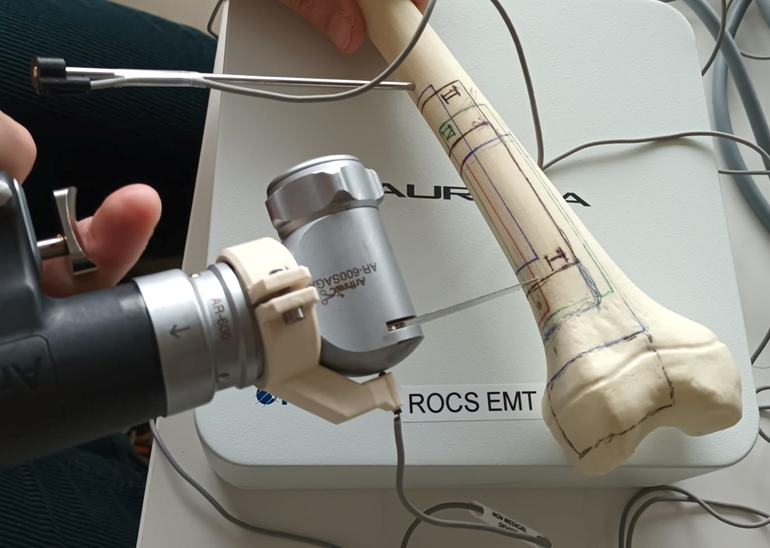Research in Orthopedics
Electromagnetic Field Guided Osteotomies in Pediatric Rotational Deformities

Rotational deformities of the lower extremities are common among the pediatric orthopedic patient population. In cases where surgical correction is indicated, the effective outcome may vary among patients. Surgical planning and intraoperative monitoring for the correction are needed in order to ensure the optimization of the overall outcome, and to reduce the occurence of insuffi cient or adverse correction. Currently available techniques for controlling rotation (encompassing international gold standard technique with K-wires, as well as 3D printed patientspecific guides) do not allow for real-time rotation tracking, or for minimally invasive surgery. These challenges are addressed by an electromagnetic field (EMT) guided tracking system.
Our project aims to compare the three different surgical techniques with respect to intraoperative rotation control and comparison of planned vs. realized rotational correction. Because no electromagnetic field tracking system for orthopedic surgery is currently available, the first phase covered the software and hardware development in close collaboration with the Professor Philipp Fürnstahl's ROCS team. In a proof of principle study, Sawbone experiments showed higher accuracy on the part of EMT guided osteotomies compared with classic K-wire controlled osteotomies and comparable accuracy with osteotomies with patient-specific instruments. Furthermore, EMT with directly visualized feedback of surgical correction allows for steeper learning curves for new surgeons. The current focus is on optimization of hard- and software, with preclinical experiments in OR-X beginning soon. The last step will be a randomized clinical trial.
Elektromagnetisch geführte Osteotomien
Die chirurgische Behandlung von pädiatrischen Rotationsdeformitäten umfasst die internationale Goldstandard-Methode mit Rotations-K-Drähten wie auch patientenspezifische Schnittblöcke (PSI). Ein präzises intraoperatives Monitoring der Korrektur und eine minimalinvasive Chirurgie sind hiermit aber nicht möglich. Ziel unseres Projekts ist, diese Herausforderungen mittels eines elektromagnetischen Tracking- (EMT-)Systems anzugehen. Die erste Phase des Projekts umfasste die Entwicklung von Hard- und Software. Im ersten Sawbone- Experiment der Proof-of-Principle-Studie konnte eine hohe Genauigkeit der EMTgeführten Osteotomien nachgewiesen werden: vergleichbar mit PSI und genauer als K-Draht-kontrollierte Eingriffe. Weiter ermöglicht das direkte visuelle Feedback des Systems jungen Orthopädinnen und Orthopäden eine steilere Lernkurve. Nach Optimierung des Systems werden bald präklinische Experimente im OR-X gestartet.
At a Glance
Electromagnetically Guided Osteotomies
Key Collaborators
Project lead: Prof. Dr. med. Thomas Dreher, Dr. med. Arend Nieuwland
Prof. Dr. Philipp Fürnstahl
Departments and Partners
Balgrist University Hospital:
Dept. of Orthopedics, Pedriatic Orthopedic Surgery Unit
Research in Orthopedic Computer Science (ROCS)
University Children's Hospital Zurich
Clinical Relevance
Improving surgical accuracy in rotational osteotomies, enabling minimal invasive surgery cervical nerve root compression
